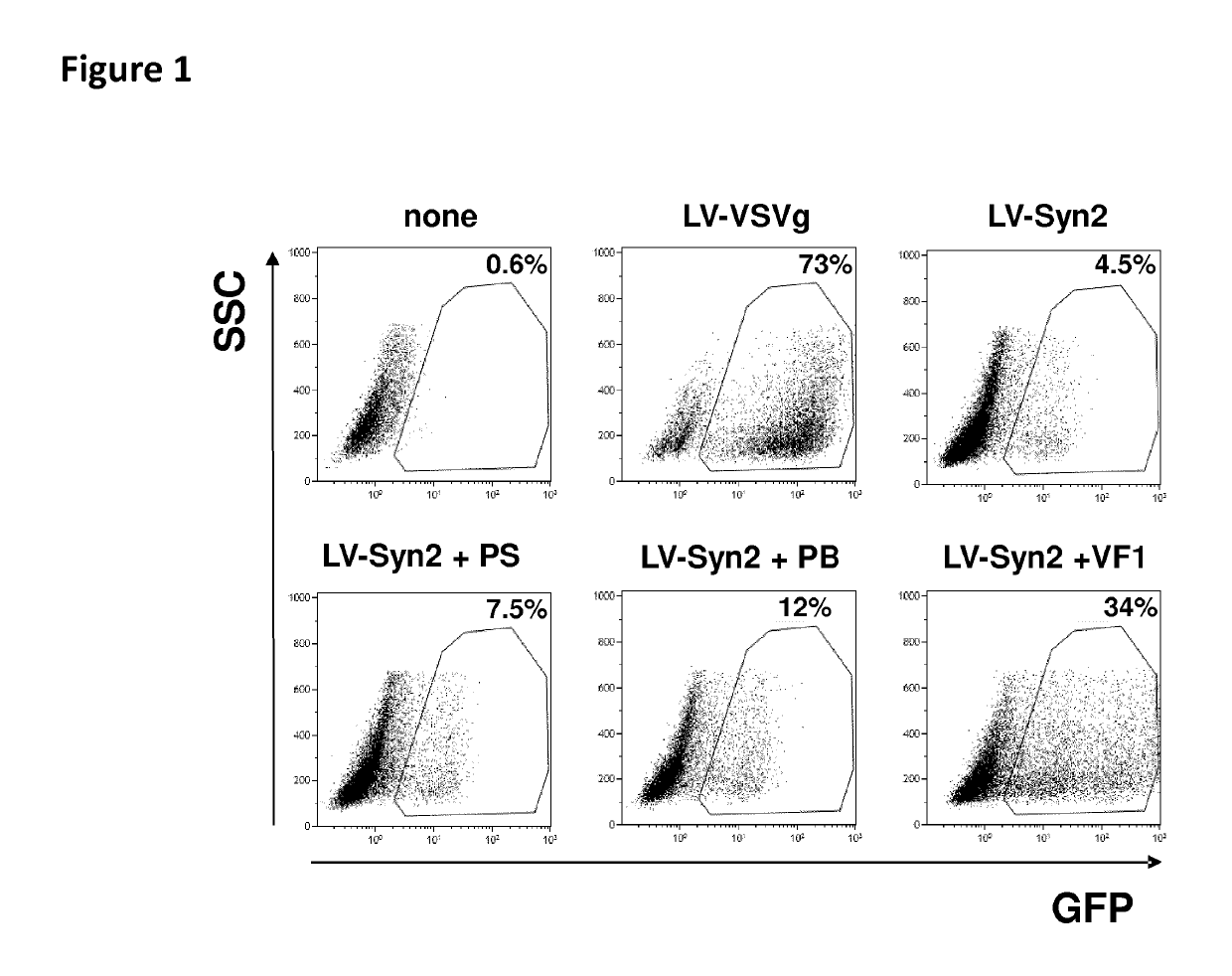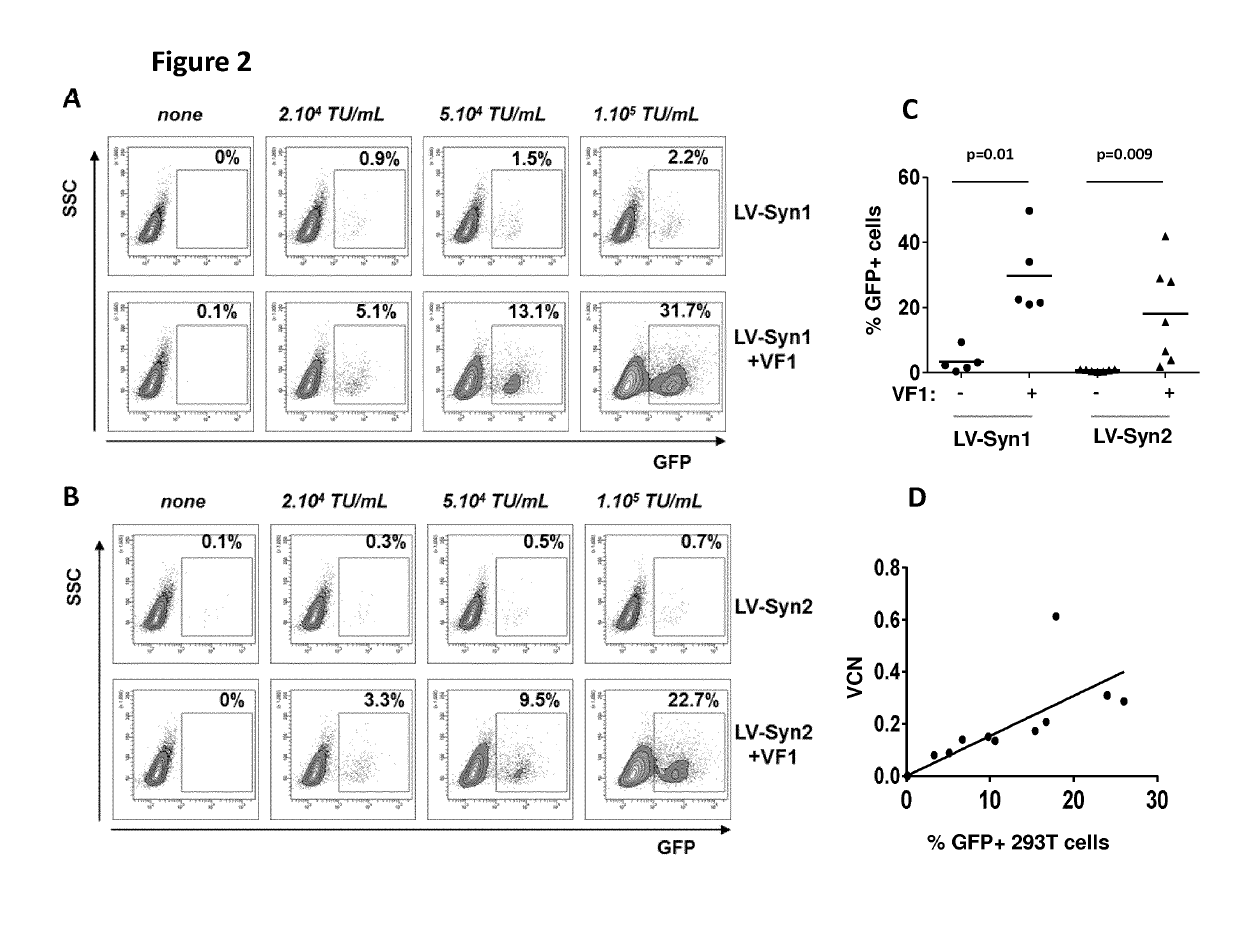Stable pseudotyped lentiviral particles and uses thereof
a pseudotyped, lentiviral technology, applied in the field of stable pseudotyped lentiviral particles, can solve the problems of difficult to establish purification protocols for some lvs, hampered gene therapy approaches, and inability to obtain highly infectious titers, etc., and achieve the effect of efficient transduction of murine b cells
- Summary
- Abstract
- Description
- Claims
- Application Information
AI Technical Summary
Benefits of technology
Problems solved by technology
Method used
Image
Examples
example 1
Human Endogenous Retroviral Envelope Glycoproteins Syncytin-1 and Syncytin-2 Enable an Effective Lentiviral Transduction of Human Primary B Cells and Dendritic Cells
[0187]Materials and Methods
[0188]Cell Lines
[0189]Human embryonic kidney 293T cells and human colorectal carcinoma HCT116 cells (CCL-247; ATCC, Manassas, Va.) were cultured at 37° C., 5% CO2 in Dulbecco's modified Eagle's medium (DMEM+glutamax) (Life Technologies, St-Aubin, France) supplemented with 10% of heat inactivated fetal calf serum (FCS) (Life Technologies). Human choriocarcinoma BeWO cells (CCL-98; ATCC) were cultured in Ham's FI2K medium (Life technologies) supplemented with 10% of FCS. Raji cells and Jurkat cells were infected in XVivo 20 medium.
[0190]Cloning of Syncytin-Expressing Plasmids and Production of Vectors
[0191]Plasmids pCDNA3-syncytin-1 and pCDNA3-syncytin-2 coding for human syncytin-1 (ERVW-1-001) or human syncytin-2 (ERVFRD-1) were constructed by cloning the respective synthesized DNA sequences (Ge...
example 2
Murine Svncytin-A and In Vivo Gene Delivery in Mice with LV-SynA. Production of Stable and Infectious LV-SvnA Particles
[0243]Materials and Methods (See Also Materials and Methods for Example 1)
[0244]Cloning of Syncytin A and production of LV-Syn A.
[0245]a. Generation of a plasmid expressing murine Syncytin-A.
[0246]The cloning of the murine syncytin-A cDNA into the HindIII and XbaI sites of the pcDNA3.1 eukaryotic expression plasmid was performed by inserting a PCR-amplified fragment from the pUC-SynA plasmid generated by Genecust (Ellange, Luxembourg) and which contains the Syn-A murine gene full-length cDNA (Ensembl reference ENSMUSG00000085957) using the following primers forward 5′ AGCAAGCTTATGGTTCGTCCTTGG 3′ (SEQ ID NO:32) (Tm=69,8° C.; % GC=50%; Sigma, Saint-Louis, USA) and reverse 5′ AGCTCTAGACTAGACGGCATCCTC 3′ (SEQ ID NO:33) (Tm=65° C.; % GC=54%; Sigma) and ligation. The plasmid was verified by sequencing (Beckman Coulter Genomics, Takeley, UK).
[0247]b. Production of Syn-A-ps...
example 3
Physical Titers Determination: Correspondence Between Phvsical Titer Obtained by p24 RT ELISA and by Direct Particle Counting with an Automated Counter
[0257]Physical titers were determined by 2 different methods for HIV-1-derived lentiviral vectors (LV) pseudotyped with syncytin-1 (S1), syncytin-2 (S2), syncytin A (SA) or with VSVg, and encoding either the truncated form of the nerve growth factor receptor (ΔNGFR) or the green fluorescent protein (GFP). The LV were produced by transient transfection, concentrated by ultracentrifugation and cryopreserved a −80° C. before titration.
[0258]The methods consisted either of (a) an ELISA measuring the p24 concentration in the sample followed by a calculation of the titer as physical particles (pp) assuming that 1 fg of p24 corresponds to 12 pp of LV (Farson ef al, 2001) or (b) using the NS300 Nanosight particle counter from Malvem Instruments (UK) which directly measures the particle concentration in the sample using automated microscopy.
SU...
PUM
| Property | Measurement | Unit |
|---|---|---|
| time | aaaaa | aaaaa |
| time | aaaaa | aaaaa |
| time | aaaaa | aaaaa |
Abstract
Description
Claims
Application Information
 Login to View More
Login to View More - R&D
- Intellectual Property
- Life Sciences
- Materials
- Tech Scout
- Unparalleled Data Quality
- Higher Quality Content
- 60% Fewer Hallucinations
Browse by: Latest US Patents, China's latest patents, Technical Efficacy Thesaurus, Application Domain, Technology Topic, Popular Technical Reports.
© 2025 PatSnap. All rights reserved.Legal|Privacy policy|Modern Slavery Act Transparency Statement|Sitemap|About US| Contact US: help@patsnap.com



